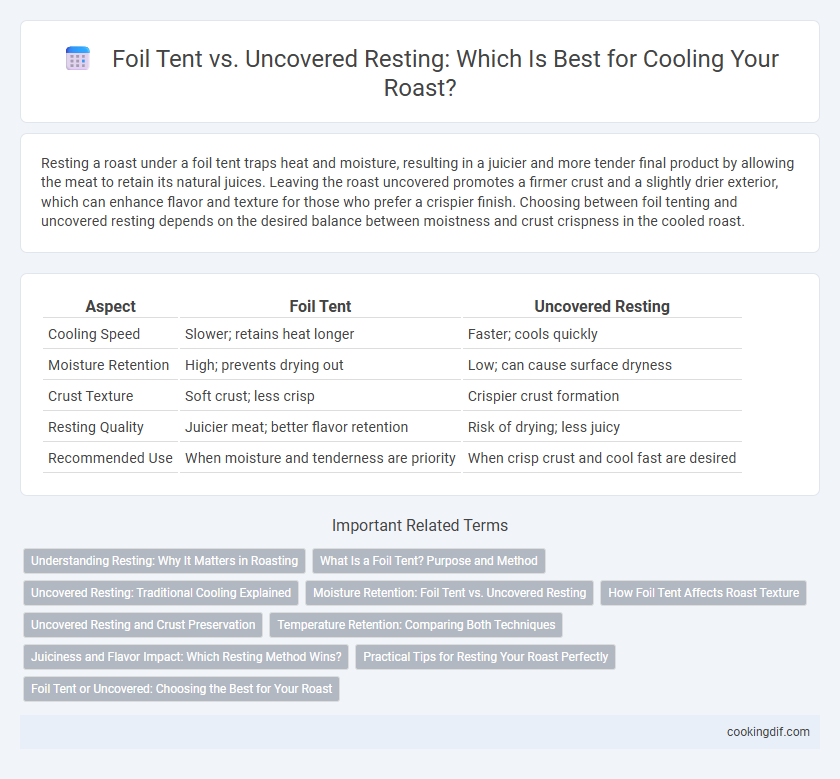Resting a roast under a foil tent traps heat and moisture, resulting in a juicier and more tender final product by allowing the meat to retain its natural juices. Leaving the roast uncovered promotes a firmer crust and a slightly drier exterior, which can enhance flavor and texture for those who prefer a crispier finish. Choosing between foil tenting and uncovered resting depends on the desired balance between moistness and crust crispness in the cooled roast.
Table of Comparison
| Aspect | Foil Tent | Uncovered Resting |
|---|---|---|
| Cooling Speed | Slower; retains heat longer | Faster; cools quickly |
| Moisture Retention | High; prevents drying out | Low; can cause surface dryness |
| Crust Texture | Soft crust; less crisp | Crispier crust formation |
| Resting Quality | Juicier meat; better flavor retention | Risk of drying; less juicy |
| Recommended Use | When moisture and tenderness are priority | When crisp crust and cool fast are desired |
Understanding Resting: Why It Matters in Roasting
Resting a roast allows juices to redistribute, enhancing tenderness and flavor by preventing moisture loss when sliced. Using a foil tent traps heat and slows cooling, maintaining a warm internal temperature that promotes even juice absorption. Leaving the roast uncovered cools it faster but risks drying the surface and losing valuable moisture essential for optimal taste and texture.
What Is a Foil Tent? Purpose and Method
A foil tent is a covering made from aluminum foil loosely placed over a roast to retain heat and moisture during resting without trapping steam that can soften the crust. Its primary purpose is to allow the meat to relax and redistribute juices evenly, enhancing tenderness and flavor while preventing excessive cooling. The method involves tenting the foil gently over the roast, ensuring it does not cling tightly, which helps maintain optimal temperature and texture.
Uncovered Resting: Traditional Cooling Explained
Uncovered resting allows the roast to cool gradually while air circulates around it, preserving the crust and enhancing flavor through natural evaporative cooling. This traditional method prevents sogginess that foil tenting can cause by trapping steam and moisture. Maintaining an uncovered rest promotes a crisp texture and balanced moisture distribution within the roast.
Moisture Retention: Foil Tent vs. Uncovered Resting
Foil tenting helps retain moisture by trapping steam released from the roast, resulting in a juicier, more tender texture. In contrast, uncovered resting allows moisture to evaporate from the surface, potentially leading to a drier crust but a firmer outer layer. Choosing foil tenting balances heat retention and moisture preservation, crucial for achieving optimal roast juiciness during the resting phase.
How Foil Tent Affects Roast Texture
Foil tents trap steam and moisture around the roast, resulting in a softer, juicier crust but potentially less crispiness. Uncovered resting allows the surface to dry and firm up, enhancing a crispy, caramelized exterior. The choice between foil tent and uncovered resting significantly impacts the texture by controlling moisture retention on the roast's surface.
Uncovered Resting and Crust Preservation
Uncovered resting allows the roast to cool naturally, preserving the crust's texture by preventing steam buildup that can soften the exterior. This method maintains a crisp, flavorful crust essential for optimal taste and mouthfeel. Leaving the roast uncovered encourages moisture evaporation, ensuring the crust remains dry and crunchy compared to foil tenting.
Temperature Retention: Comparing Both Techniques
Foil tents retain heat effectively by trapping steam and preventing moisture loss, maintaining a higher internal temperature during roast resting. An uncovered resting environment allows the roast to cool more rapidly due to exposure to air, which can result in a lower final serving temperature. Temperature retention under foil enhances juiciness and tenderness, while uncovered resting promotes a firmer crust but risks significant heat loss.
Juiciness and Flavor Impact: Which Resting Method Wins?
Resting a roast in a foil tent retains more moisture by trapping steam, which enhances juiciness but can soften the crust, potentially diminishing flavor complexity. An uncovered rest promotes evaporation, concentrating flavors and maintaining a crisp exterior, though it may lead to slight moisture loss. Balancing juiciness and flavor impact depends on the desired roast characteristics, with foil tents favoring tender, juicy results and uncovered resting boosting flavor intensity and texture.
Practical Tips for Resting Your Roast Perfectly
Resting your roast under a foil tent retains warmth while preventing condensation buildup that can lead to a soggy crust, promoting even cooling and flavor preservation. Leaving the roast uncovered allows the exterior to crisp further but risks faster heat loss and uneven cooling. Optimal resting involves tenting loosely with foil to balance moisture retention and crust texture, enhancing juiciness and overall roast quality.
Foil Tent or Uncovered: Choosing the Best for Your Roast
Foil tenting helps retain heat and moisture in a roast, preventing it from drying out during the resting phase, which enhances juiciness and tenderness. Uncovered resting allows the roast to cool faster, encouraging a firmer crust but may result in moisture loss and drier meat. Choosing between foil tenting and uncovered resting depends on whether preserving internal juiciness or developing a crispy exterior is your priority.
Foil tent vs uncovered resting for roast cooling Infographic

 cookingdif.com
cookingdif.com